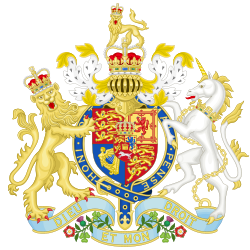Woollen Trade Act 1833
| Act of Parliament | |
 | |
| Long title | An Act to repeal an Act of the Thirteenth Year of His Majesty King George the First, for the better Regulation of the Woollen Trade. |
|---|---|
| Citation | 3 & 4 Will. 4. c. 28 |
| Introduced by | George Howard, 7th Earl of Carlisle MP (Commons) |
| Territorial extent | United Kingdom |
| Dates | |
| Royal assent | 24 July 1833 |
| Commencement | 24 July 1833[a] |
| Repealed | 16 July 1874 |
| Other legislation | |
| Repeals/revokes | See § Repealed enactments |
| Repealed by | Statute Law Revision Act 1874 |
| Relates to | |
Status: Repealed | |
| Text of statute as originally enacted | |
The Woollen Trade Act 1833 (3 & 4 Will. 4. c. 28) was an act of the Parliament of the United Kingdom that repealed the Woollen Manufacture Act 1726 (13 Geo. 1. c. 23).
Background
[edit]The committee appointed to consider of the state of the woollen manufacture of England reported on 19 May 1808,[1] resolving to repeal various old acts relating to the manufacture of wool in the United Kingdom.[2]
In 1809 and 1810 respectively, the Woollen Manufacture Act 1809 (49 Geo. 3. c. 109) and the Woollen Manufacture Act 1810 (50 Geo. 3. c. 83) were passed, which repealed over 40 enactments related to the manufacture of wool in the United Kingdom.
Passage
[edit]Leave to bring in the Woollen Trade Bill to the House of Commons was granted to George Howard, 7th Earl of Carlisle MP, Sir George Strickland, 7th Baronet MP and John Marshall MP on 14 June 1833.[3] The bill had its first reading in the House of Commons on 14 June 1833, presented by George Howard, 7th Earl of Carlisle MP, MP.[3] The bill had its second reading in the House of Commons on 18 June 1833 and was committed to a committee of the whole house,[3] which met and reported on 18 June 1833, without amendments.[3] The bill had its third reading in the House of Commons on 19 June 1833 and passed, without amendments.[3]
The bill had its first reading in the House of Lords on 20 June 1833.[4] The bill had its second reading in the House of Lords on 21 June 1833 and was committed to a committee of the whole house.[4] The bill was committed to a select committee on 3 July 1833 to consider the petition of Spinners of Wool and Weavers employed in the West Riding of the County of York, consisting of 17 members:
The select committee resolved in favour of the bill on 9 July 1833 and the bill was committed to a committee of the whole house,[4] which met and reported on 10 July 1833, without amendments.[4] The bill had its third reading in the House of Lords on 11 July 1833 and passed, without amendments.[4]
The bill was granted royal assent on 24 July 1833.[4]
Provisions
[edit]Section 1 of the act repealed the Woollen Manufacture Act 1726 (13 Geo. 1. c. 23).[5]
Legacy
[edit]The whole act was repealed by section 1 of, and the schedule to, the Statute Law Revision Act 1874 (37 & 38 Vict. c. 35).
Notes
[edit]References
[edit]- ^ Commons, Great Britain House of (1809). The Journals of the House of Commons. Vol. 64. pp. 209, 212, 244, 268, 274, 295, 307–308, 315, 320, 326, 330, 341, 346, 349, 353, 363, 368, 405.
- ^ Commons, Great Britain House of (1808). The Journals of the House of Commons. Vol. 63. pp. 344–347.
- ^ a b c d e Commons, Great Britain House of (1833). The Journals of the House of Commons. Vol. 88. Out-of-copyright. pp. 485, 486, 493, 498, 503, 565, 599.
- ^ a b c d e f Lords, Great Britain Parliament House of (1833). The Journals of the House of Lords. Vol. 65. H.M. Stationery Office. pp. 441, 444, 469, 470, 472, 474, 477, 487, 488, 518, 519.
- ^ Britain, Great (1833). The Statutes at Large from the Magna Charta, to the End of the Eleventh Parliament of Great Britain, Anno 1761 [continued to 1806]. By Danby Pickering. Vol. 73. J. Bentham. p. 151.
